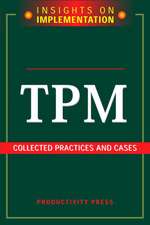Productivity Analysis: A Range of Perspectives: Studies in Productivity Analysis, cartea 1
Editat de Ali Dogramacien Limba Engleză Paperback – 29 feb 2012
Preț: 382.18 lei
Nou
Puncte Express: 573
Preț estimativ în valută:
73.15€ • 75.38$ • 61.76£
73.15€ • 75.38$ • 61.76£
Carte tipărită la comandă
Livrare economică 03-17 martie
Preluare comenzi: 021 569.72.76
Specificații
ISBN-13: 9789401174046
ISBN-10: 9401174040
Pagini: 192
Ilustrații: 192 p.
Dimensiuni: 155 x 235 x 10 mm
Greutate: 0.28 kg
Ediția:1981
Editura: SPRINGER NETHERLANDS
Colecția Springer
Seria Studies in Productivity Analysis
Locul publicării:Dordrecht, Netherlands
ISBN-10: 9401174040
Pagini: 192
Ilustrații: 192 p.
Dimensiuni: 155 x 235 x 10 mm
Greutate: 0.28 kg
Ediția:1981
Editura: SPRINGER NETHERLANDS
Colecția Springer
Seria Studies in Productivity Analysis
Locul publicării:Dordrecht, Netherlands
Public țintă
ResearchCuprins
1 Perspectives on Productivity.- 1.1 Introduction.- 1.2 Importance of Productivity Growth.- 1.3 The Measurement of Productivity.- 1.4 More on the Range of Productivity Analysis.- 1.5 Concluding Remarks.- Notes.- References.- 2 Issues in Productivity Measurement and Analysis.- 2.1 Introduction.- 2.2 The Slowdown of U.S. Productivity Growth.- 2.3 Measurement Problems.- 2.4 Timing of the Slowdown.- 2.5 Accounting for the Slowdown.- 2.6 Final Remarks.- Notes.- References.- 3 Basic Forces in Productivity Growth.- 3.1 Introduction.- 3.2 Challenges to “Policy”.- 3.3 Capital Formation.- 3.4 Technological Progress.- 3.5 Freedom.- 3.6 Concluding Comment.- Notes.- References.- 4 Capital Formation and U.S. Productivity Growth, 1948–1976.- 4.1 Introduction.- 4.2 Sectoral Value Added.- 4.3 Aggregate Production.- 4.4 Growth in Output and Inputs.- 4.5 Contribution to Economic Growth.- 4.6 Decomposition of Capital Input.- 4.7 Decomposition of Technical Change.- 4.8 Conclusion.- Notes.- References.- 5 Productivity Change as a Function of Variation in Microeconomy.- 5.1 Introduction.- 5.2 Cost Minimizing.- 5.3 Cost Maximizing.- 5.4 Cost Pass-Along.- 5.5 Conclusion.- Notes.- References.- 6 Improving Industrial Productivity and Technological Capabilities: Needs, Problems, and Suggested Policies.- 6.1 Introduction.- 6.2 Basic Objectives.- 6.3 Needed Revisions of Basic Concepts.- 6.4 Some Shortcomings of Common Productivity Measures.- 6.5 Strengthening Productivity Analysis.- 6.6 Primary Sources of Productivity Adjustments.- 6.7 Effects of Changes in Technology and Productivity Relationships.- 6.8 Productivity and Technology Improvement Efforts: Deterrents and Potential Remedial Measures.- Notes.- References.- 7 Productivity and Production Management.- 7.1 Introduction.- 7.2 Perceptionof a Productivity Problem.- 7.3 Causes of Productivity Problems.- 7.4 Failure to Use the Systems Approach.- 7.5 Higher Volume Work Configurations.- 7.6 Assembling High Demand Volume.- 7.7 Greater Reliance on Methodological Innovation.- 7.8 The Achievement of Renewable Growth.- References.- 8 Productivity and Organization Management.- 8.1 Introduction.- 8.2 Technical Progress.- 8.3 The Rational/Adaptable Organization.- 8.4 Changing Purpose.- 8.5 The Competitive/Progressive Organization.- 8.6 Changing Values.- 8.7 The Innovating/Improving Organization.- 8.8 Creative Environment.- 8.9 Innovative Process.- 8.10 Planned Change.- 8.11 Review.- References.- Name Index.























